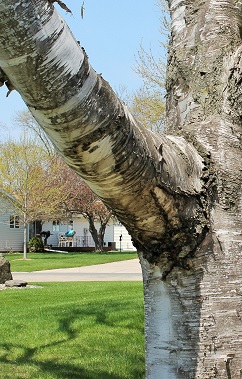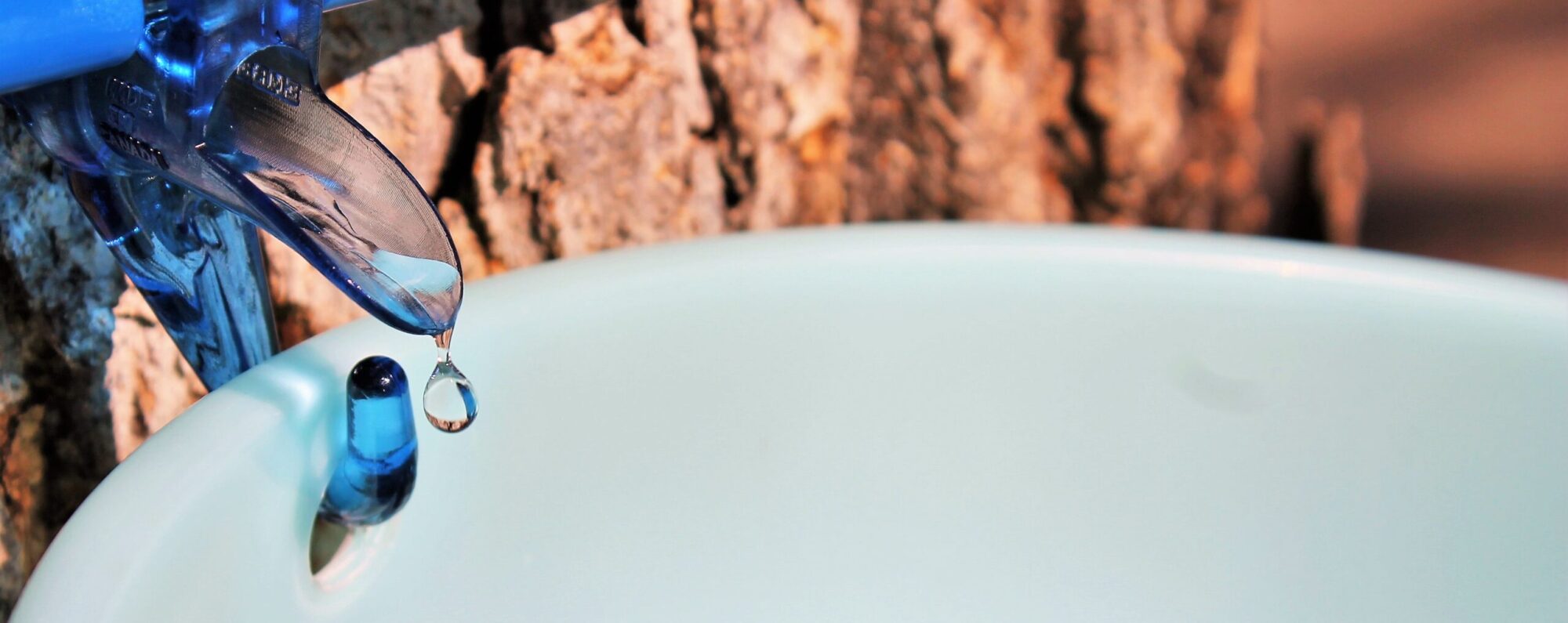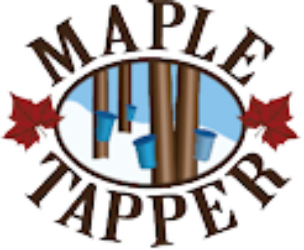
Every tree has some “sugar” in its sap but not all of this sap is as delicious or as concentrated as sugar maple sap. Many regions, though, without abundant sugar maples tap other trees to collect sap water, boil into syrup, and further cook into candy or sugar. Each variety of tree sap will have a different flavor, color, and even sweetness but this non-sugar maple syrup can be an acquired taste!
Editor’s Note: Please forgive this long article but I wanted to cover this topic in full! If you’d like to skip ahead, sections include: Maple Family Trees (i.e. soft maples); Birch trees (and their unique cooking needs); and other trees such as Black Walnut. This article has been excerpted from our newly updated Guide to Maple Tapping which is included with each kit and available separately for print or ebook here.
As with sugar maples, always select healthy trees, empty your buckets often, and remove taps as soon as buds appear. You can generally use the same equipment for all types of sap but some differences are needed in filtering and cooking equipment and those are mentioned in the following sections. Time and effort needed will be the biggest difference you notice with non-sugar maple sap. Because the sugar content is usually lower, you’ll need much more sap and longer boil times to produce the same quantity of finished syrup. For example, birch trees typically have a 100-to-1 sap to syrup yield so 100 gallons of sap yields one gallon of syrup. This is nearly three times that of sugar maple sap which usually falls in the 30- to 40-to-1 range. That difference makes for more work in the field in tapping trees and hauling sap and more fuel and time required for boiling.
The season for sugaring is generally the same – some trees start later such as birch and some last longer such as walnut. The freeze/thaw cycle does affect how well sap flows but in more temperate regions such as the Western United States, trees can be tapped all winter as long as they’re dormant. In all cases, sap will not produce good-tasting syrup if the tree is in bud or growing leaves.
Maple Family Trees
While most focus on sugar maples, there are many other trees within the maple family and many such as silver maple yield a sweet sap with relatively high sugar content. Here’s a quick list of trees to try:
Black Maple (Acer nigrum): This variety most closely resembles a sugar maple and the two are often confused. Black Maple trees have a more limited range but its sap is nearly as sweet and abundant as a sugar maple.
Red Maple (Acer rubrum): Widely spread throughout North America, Red Maple is recognized as America’s most common variety of tree and is known for its beautiful fall colors.This tree is also very suitable for tapping but the sap has a lower sugar content and the buds pop out sooner than sugar maple.
Silver Maple (Acer saccharinum):This fast-growing soft maple is also widely spread throughout North America. It, too, has lower sugar content (approximately 1.7% versus 2% of sugar maples) and the tree buds out earlier making for a shorter season. Finished syrup has a more earthy taste and will be lighter-colored and thinner.
Box Elder, also called Ash-Leaved Maple or Manitoba Maple (Acer negundo): Another hardy and fast-growing but short-lived maple variety, Box Elder sap has lower sugar content and syrup has a more sorghum-like flavor.
Norway Maple (Acer platanoides): Another tree similar to the sugar maple, the Norway Maple’s sap is less sweet. This tree tolerates poor growing conditions but and is now considered invasive in many part of the United States.
Canyon Maple, also known as Big Tooth Maple (Acer grandidentatum):This tree is closely related to the sugar maple and is native to interior western North America. Its range extends from Western Montana to northern Mexico. Sugar content is higher than most maples but sap yield is much lower than sugar maples.
Bigleaf Maple (Acer macrophyllum): Another western native, Bigleaf Maples grow mostly along the Pacific coast from Alaska all the way to southern California. Sap has lower sugar content and less sap yield compared to sugar maples.
Rocky Mountain Maple (Acer glabrum): Also native to western North America, Rocky Mountain Maple sap has been used for centuries by Native Americans as a medicinal treatment for swelling and other general ailments.
Birch Trees
Likely the most common non-maple tree used for syrup, birch is tapped in regions such as Alaska where maple trees are not abundant. The Alaskans really ramped up birch syrup production in response to World War I sugar shortages and they now have a thriving cottage industry, making everything from birch syrup to beer to wine to vinegar to soft drinks. Birch sap straight out of the tree is valued by many as a sweet spring tonic (much like mineral water) or as base for tea and coffee. It’s also bottled and sold commercially in Europe, China, Korea, Finland, and Russia. Finished birch syrup tastes more savory than sweet with rich body and hints of caramel, sorghum, honey, and even balsamic. These flavors may not pair well with pancakes but are great for marinades, dressings, meats, and veggies.
Birch sugarmaking differs in a few ways from maple sugaring. The sap run usually begins later in the year in early April, often at the end of the maple sugaring season. Daytime temperatures need to get into high 40°s and low 50°s with cold nights to get the sap flowing. Because of this late-season harvest and warmer weather, the sap spoils more quickly if left sitting all day in the buckets so birch sugarmakers often must collect sap twice per day. The season, too, is shorter and typically lasts for only two to three weeks. You can only use one tap per tree no matter what size the tree but choose a tree at least 10” in diameter. The sap itself is more acidic which can eat away at metal containers, leaving behind an unpleasant taste. So, you should only use plastic, nylon, stainless steel, or glass during tapping, collecting, cooking, and storage.
Cooking Birch Sap is a Bit Different
The predominant sugar in birch sap is fructose (as opposed to sucrose in maple sap) which gives it the lowest glycemic index of all sugars. The fructose, though, also means birch syrup scorches more easily and will darken more with boiling. For this reason, the cooking process is a bit more labor intensive than maple syrup cooking. Almost the exact opposite of how we make maple syrup, the birch sugarmaker has to go by sight to tell when the syrup is close to done. The thermometer does still matter – only because your goal is to keep the temperature under 200°F. Anything above that and your batch will burn and that’s the end of it!
Because it’s so finicky, most commercial producers use reverse osmosis for the majority of processing and only boil it at the end for flavor. You can cook it at home with your evaporator but it needs to cook at a lower temperature and at a much less aggressive boil. Most birch sugarmakers cook birch sap using a three step process:
1. Boil in a traditional evaporator until volume is reduced by half. Do not add sap to the batch as it cooks, though, as it can cause scorching of already-boiling sap.
2. Transfer this reduced sap to a smaller pan and cook at a low simmer. Keep the temperature below 200°F and do not let it boil. If it starts turning dark brown, remove from heat immediately. Continue this simmer until sap is reduced to about 25% of the original volume.
3. Transfer this sap to a crockpot and set temperature on low but leave the lid off so water can continue evaporation. This can also be done in a double boiler. Again, make sure the temperature does not go above 200°F. Continue cooking until syrup starts to thicken and turn golden amber. Finished birch syrup will not be as thick as pure maple syrup but should read between 66 and 67 on the Brix scale. Be sure to filter it as you would with maple syrup and seal while hot in glass jars.
Any tree in the Betula family will produce birch sap but most prefer Paper Birch:
White Birch, also called Paper Birch or Canoe Birch (Betula papyrifera): The provincial tree of Saskatchewan and the state tree of New Hampshire, the white birch has half the sugar content of sugar maple sap but is considered the sweetest sap of all birches.
Yellow Birch (Betula alleghaniensis): The sap from this variety of birch has been found to have higher mineral composition and higher antioxidant value than sugar maple. Sap from the yellow birch is much lower in sugar content and the tree buds out sooner making for a shorter season. Finished syrup has a caramel-like flavor.
Black Birch, sometimes called Sweet Birch (Betula lenta): This tree is native to eastern North America and grows from Ontario to Georgia. The sap is most commonly used to make birch beer.
Other Trees to Try
Call it desperation or ingenuity, the sugarmaking community is filled with tales of surprisingly tasty syrup made from unusual sources. Trees, such as Black Walnut, have been overshadowed by Maple but are now getting serious study as another valuable source of sap and syrup. Researchers are finding promise not only in a tasty end product but in another avenue for small agricultural markets. Because so little research exists, tapping these non-traditional trees is still somewhat of a trial-and-error experience. As a home hobbyist, it’s an opportunity to be adventurous and try something new. Follow the same tapping and boiling process as you would with maple syrup. Note: anyone with nut allergies should avoid syrup made from nut-producing trees such as walnut or butternut.
Black Walnut (Juglans nigra) or Butternut (Juglans cinerea): Most commonly found in the Midwest and northeastern U.S., walnut and butternut tree syrup is darker than maple syrup with a more earthy, nutty flavor. The sap flow depends on the same freeze/thaw cycle and the season begins at the same time. The length of the season, though, is sometimes a bit longer as these trees are often the last to bud out. You will notice that the color of the sap will darken over the season and the darker it gets, the more robust the finished syrup will taste.
Sugar content is similar to maple trees and you can expect a 40-to-1 sap to syrup yield. However, the amount of sap produced by the tree is typically about one-third less than sugar maple. The sap also contains more pectin than maple sap – the same type used to make jams and jellies so the sap is thicker and harder to filter and traditional thick, wool filters will not work. Try cheesecloth or a clean thin cotton dish towel. Walnut trees also have thicker bark which can be harder to drill through but trees can be tapped at a smaller diameter (8” versus 12”). The cooking process is exactly the same as maple syrup.
Sycamore (Platanus occidentalis): Found in southern Ontario and much of northern and eastern America, Sycamore tree sap has long been collected as drinking water and for syrup making. The tapping season and sugarmaking process are identical to maple trees and the sap-to-syrup ratio is similar. The flavor, though, is not the greatest and many considered this a “syrup of last resort” due to its almost-scorched taste. It can, though, be blended with other saps and will add a bit of butterscotch flavor when mixed with maple or other syrups.
Hickory (Carya genus): The Pecan tree is also part of this family and old-timers have tapped both types for their sap which is cooked down just like maple syrup. However, most “Hickory Syrups” sold today are not made from tree sap but instead from an extract taken from the bark and nut shells which is then combined with sugar and water to make syrup.
Good luck and let us know how you’re sugarmaking goes with these non-traditional trees!

